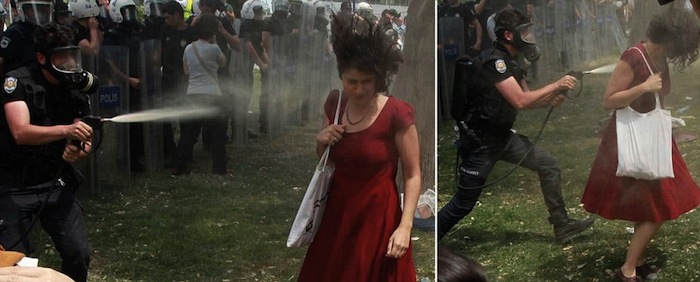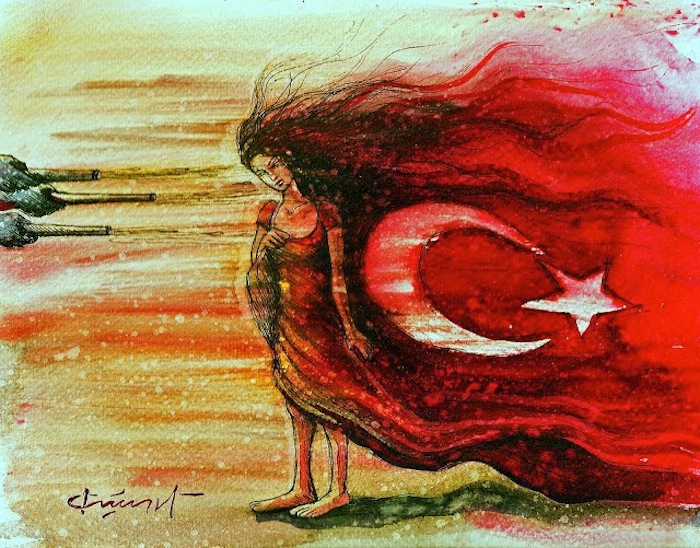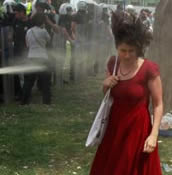Lady in Red became a Capulcu
Modfied version, first published by Amar Toor on The Verge
On May 28th, Ceyda Sungur – an academic in Istanbul – became the “Lady in Red” — an unwitting symbol of the protests in Turkey and a disproportionate force used to quell them.
Sungur, a research assistant at Istanbul Technical University’s school of urban planning, was among the hundreds of demonstrators gathered at Istanbul’s Gezi Park at the beginning of the protests, where environmentalists and others had been staging a peaceful protest against government plans to break down the park and convert the area into a shopping center.

Photos by Osman Orsal
By the time Sungur arrived at the park, the scene had devolved into violence, with police attempting to disperse protesters with tear gas, pepper spray, and water cannons. The clashes at Gezi Park have since sparked a large movement across the country, with demonstrators taking to the streets in protest against Prime Minister Recep Tayyip Erdogan, who many see as increasingly authoritarian and socially conservative.
Dressed in a red cotton dress and carrying a white tote bag, Sungur soon found herself nearly face-to-face with a policeman’s pepper spray canister. That’s precisely when Osman Orsal, a photographer for Reuters, captured what may be the defining image of the unrest.
With her stance relaxed and face downturn, Sungur, through Orsal’s lens, is the epitome of passive resistance. As onlookers cover their faces and turn away, Sungur keeps her shoulders nearly squared to the officer, whose gas mask and crouched stance seem almost comically disproportionate to his target. With a barricade of shields framing the action with ominous uniformity, she stands alone and absorbs the spray.
Paul Hansen, a Swedish photojournalist, says Orsal’s image derives much of its power from the stark dissonance between its principals.
“For me, it’s the contrast between the aggressive posture, gear, and action by the policeman, and the young woman in a red dress, looking like she would be on her way to a celebratory event or something,” Hansen said. “A little bit of Beauty and the Beast, to put it in Disney terms.”
Orsal’s photo spread like wildfire across social media, with Sungur’s likeness spawning a meme of its own. Across Turkey, the protestors (capulcu’s) have appropriated her red dress, handbag, and swirling black hair to create posters, graphics, and, in at least one instance, a cardboard billboard in Izmir, where people are invited to place their face above a drawing of Sungur’s body.

Observers, too, have pointed to it as a bold rebuttal to Erdogan, who earlier characterized Turkey’s protesters as “capulcu”.
On a thematic level, Sungur’s image bears a remarkable likeness to another photo of a woman being sprayed with a water cannon in Istanbul. The image, captured from different angles by the Associated Press and Turkey’s Anadolu news agency, shows an unnamed “Lady in Blue” standing proudly in front of the cannon, her arms outstretched as water cascades down on her.

In each case, Sungur and her anonymous counterpart succumb to police force, albeit in different ways. Whereas Sungur’s stance is casual and unassuming, the Lady in Blue seems to dare the police to hose her down, extending her arms in a defiant show of non-aggression.
It’s also somewhat fitting that two of the most powerful symbols of Turkish resistance would be women. Although Turkey’s protests stem from a wide range of issues and government policies, some of the most hotly contested are those with a direct impact on the country’s female population.

“One of the truly remarkable aspects of the recent protests in Istanbul and around the country has been the level of participation and visibility of women,” says Anna Wood, an American freelance journalist living in Istanbul. “Easily half the crowd at any given protest that I’ve seen has been female.”
Wood says the response from female protesters likely stems from a series of controversial policies implemented or proposed under Erdogan’s 10-year tenure. On previous occasions, the prime minister has urged every woman to have at least three children, and has pushed legislation restricting access to abortions and birth control.
“In the past year alone, abortion, voluntary cesarean sections and the morning-after pill have all come under attack,” Wood said in an email to The Verge. “These are very real and very serious threats to female autonomy in Turkey, where women — particularly better-off, better educated women — have long been a prominent and liberated part of society.”
“Every citizen defending their human rights, every worker defending their human rights, and every student defending university rights has witnessed the police violence I experienced,” Sungur said in an interview.
“A lot of people no different from me were out protecting the park, defending their rights, defending democracy,” she continued. “They also got gassed.”
Update: In June 2015 the police man who sprayed the pepper gas in Ceyda Sungur’s face got convicted by Istanbul 73th Penal Court of First Instance. He was sentenced to 20 months in jail and to plant 600 trees. Although the officer Fatih Z. will not be send to prison because the court suspended the execution of the sentence, he has to take care of all the trees for the following six months.
Photos and images by capuling community
How it starts: Istanbul on Gas





